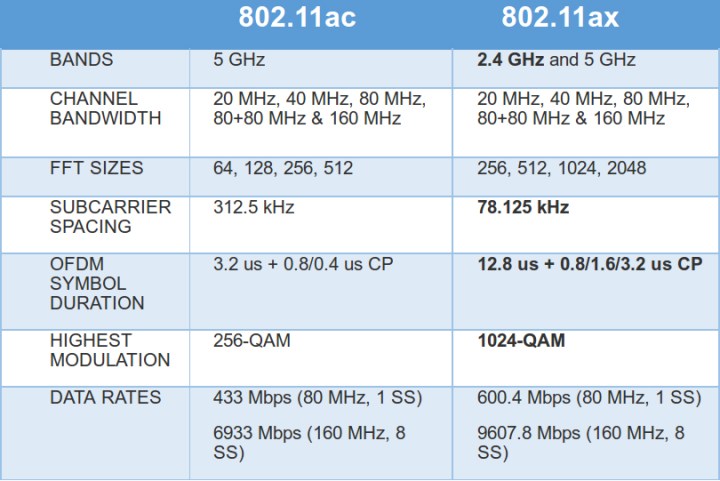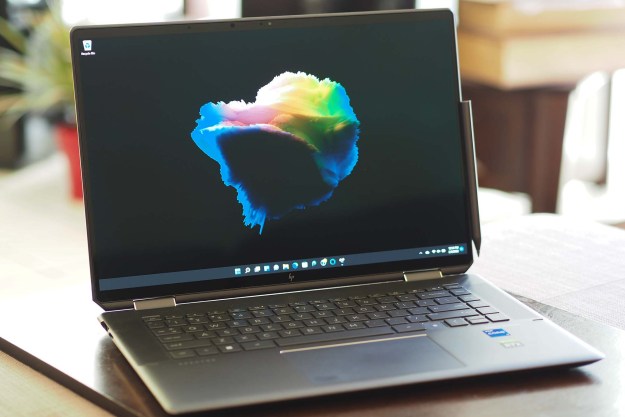
According to estimates by the Organization for Economic Cooperation and Development, the number of internet-connected gadgets for an average family of four is now at 10 per household. The cross-government trade group estimates that number will reach 50 wirelessly connected devices by 2022 — all competing for the same bandwidth, over the same connection.
The 6th generation of Wi-Fi has been certified.
“The Wi-Fi device and traffic explosion, higher density Wi-Fi deployments, growing use of outdoor Wi-Fi, and the need to support a great variety of different device types will require more efficient Wi-Fi implementations that can help to deliver richer experiences for enterprise and consumer applications that are hungry for bandwidth,” according to Andrew Zignani, Senior Analyst at ABI Research.
The good news in all this is that the people who tend to Wi-Fi standards haven’t been idle. The 6th generation of Wi-Fi, 802.11ax, is in the final stages of certification, and new products based on the standard are underway. Broadcom, a maker of circuit boards and other gizmos that drive today’s information technology, has just announced Max Wifi, the first 802.11ax chips designed for use in routers for homes and businesses, as well as wireless gadgets such as smartphones and tablets.
The need for massive increases in bandwidth and throughput is upon us. The question is, is 802.11ax enough, or is it too little too late?
How will 802.11ax manage your home network?
While 802.11ax does provide impressive bandwidth, which we’ll get to in a moment, incredible isn’t enough for this brave new world of multiple Wi-Fi devices per individual. Balancing that bandwidth between devices is equally if not more important.
The 802.11ax standard brings with it many new features, including a few responsible for a much-needed increase in the standard’s quality of service (QoS) – the term used by the industry when discussing how Wi-Fi resources are used. Here’s a look at the terms and features you’ll see tossed around:
- Uplink and Downlink Orthogonal Frequency Division Multiple Access (OFDMA): This feature significantly enhances capacity and efficiency by maintaining the integrity of the wireless network, allowing several devices to exchange data simultaneously by deploying sophisticated uplink and downlink scheduling. In other words, it helps maintain multiple data streams.
- Multi-User MIMO (MU-MIMO): Helps increase channel capacity when multiple devices are connected, thereby improving per-user throughput in dense user environments.
- Target Wake Time (TWT): This one helps improve battery life on smartphones and other mobile devices by improving wake and sleep efficiency (maintaining Wi-Fi connections when a mobile gadget is inactive currently sucks up a lot of battery life).
- Spatial Reuse: Allows access points (routers) to make more intelligent decisions on when to transmit data.
- Bluetooth 5.0: The mobile device portion of the 802.11ax (more on that coming up) contains the latest version of Bluetooth, thereby providing extended connectivity options.
How fast is 802.11ax?
Like the current standard, the new one allows multiple streams. Yet the new standard dramatically increases the maximum throughput of each stream. In addition, it operates more efficiently in the 5GHz band, where there’s a lot more room for high-bandwidth data channels.

The throughput claims are as high as eight times the current standard, but for this discussion we’ll assume the more conservative four-times estimate. The current standard delivers 866 Megabits per second (Mbps); four times that is 3.5 Gigabits per second (Gbps). Both the current and new standard support four concurrent channels, which comes out to about 3.5Gbps for 802.11ac, and 14Gbps for 802.11ax.
That may sound like a lot, but if you think about 50 devices in your household or business, with several of them streaming video, gaming, uploading large photos, and so on, you can see how it might be used up. If you already have several computers, smartphones, tablets, and TVs vying for bandwidth now, then you already know how their competition for resources can ruin your internet experience. Does 14Gbps still sound like overkill?
When can you get yours?
Soon. Broadcom is already selling its Max Wifi chips, one version for home routers, one for enterprise access points, and a third for mobile devices. And several companies, including Asus, D-Link, Netgear, Microsoft, and several others, are building access points around the Max WiFi chips. Current estimates are that we’ll start seeing 802.11ax hardware by the end of 2017.
Deploying it in either your home or office will require new hardware.
“D-LINK is working aggressively with Broadcom to bring the advances of 802.11ax technology to our customers,” the CEO of D-Link, Anny Wei, told Digital Trends. “With the 6th generation of Wi-Fi, users can expect to connect more devices with better reliability and faster speeds.”
Keep in mind that your current PCs, smartphones, mobile devices, and every other Wi-Fi device you own, including your router, does not currently support 802.11ax, nor will you in most cases be able to upgrade them to do so. Deploying it in either your home or office will require new hardware — even in most cases new smartphones. You won’t see a benefit from 802.11ax unless both your devices and your router support the standard.
“802.11ax advancements promise to expand the Wi-Fi market, particularly in segments where there are higher user densities such as the home, enterprise and public venues,” Christian Kim, Senior Analyst IoT, Connectivity, and Telecom Electronics at IHS Markit, told us. “We estimate that the total 802.11ax enabled device shipments will increase from 116 thousand units in 2019 to 58 million units in 2021.”
When that happens, upgrading should be cheaper — and by then you’ll probably need a new phone anyway.


